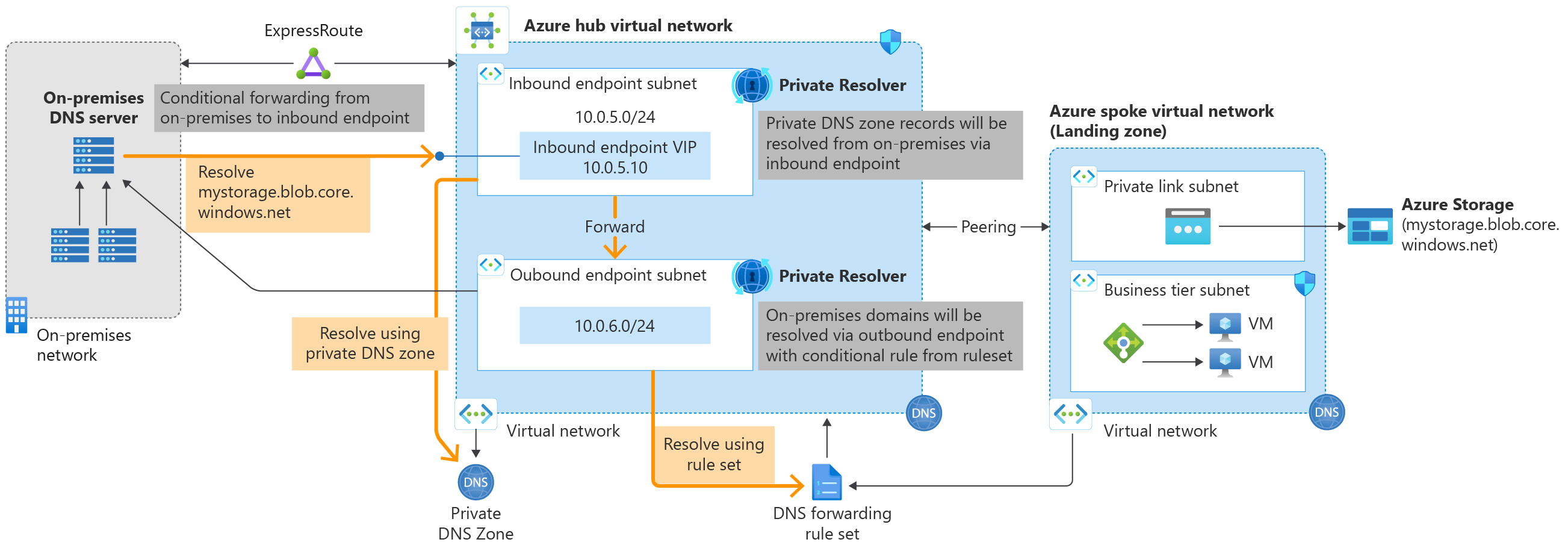What Is Azure DNS Private Resolver

In this article
- How does it work?
- Azure DNS Private Resolver benefits
- Regional availability
- Data residency
- DNS resolver endpoints and rulesets
- Inbound endpoints
- Outbound endpoints
- Virtual network links
- DNS forwarding rulesets
- DNS forwarding rules
- Restrictions:
- Next steps
Azure DNS Private Resolver is a new service that enables you to query Azure DNS private zones from an on-premises environment and vice versa without deploying VM based DNS servers.
How does it work?
Azure DNS Private Resolver requires an Azure Virtual Network. When you create an Azure DNS Private Resolver inside a virtual network, one or more inbound endpoints are established that can be used as the destination for DNS queries. The resolver's outbound endpoint processes DNS queries based on a DNS forwarding ruleset that you configure. DNS queries that are initiated in networks linked to a ruleset can be sent to other DNS servers.
You don't need to change any DNS client settings on your virtual machines (VMs) to use the Azure DNS Private Resolver.
The DNS query process when using an Azure DNS Private Resolver is summarized below:
- A client in a virtual network issues a DNS query.
- If the DNS servers for this virtual network are specified as custom, then the query is forwarded to the specified IP addresses.
- If Default (Azure-provided) DNS servers are configured in the virtual network, and there are Private DNS zones linked to the same virtual network, these zones are consulted.
- If the query doesn't match a Private DNS zone linked to the virtual network, then Virtual network links for DNS forwarding rulesets are consulted.
- If no ruleset links are present, then Azure DNS is used to resolve the query.
- If ruleset links are present, the DNS forwarding rules are evaluated.
- If a suffix match is found, the query is forwarded to the specified address.
- If multiple matches are present, the longest suffix is used.
- If no match is found, no DNS forwarding occurs and Azure DNS is used to resolve the query.
The architecture for Azure DNS Private Resolver is summarized in the following figure. DNS resolution between Azure virtual networks and on-premises networks requires Azure ExpressRoute or a VPN.

Figure 1: Azure DNS Private Resolver architecture
For more information about creating a private DNS resolver, see:
- Quickstart: Create an Azure DNS Private Resolver using the Azure portal
- Quickstart: Create an Azure DNS Private Resolver using Azure PowerShell
Azure DNS Private Resolver benefits
Azure DNS Private Resolver provides the following benefits:
- Fully managed: Built-in high availability, zone redundancy.
- Cost reduction: Reduce operating costs and run at a fraction of the price of traditional IaaS solutions.
- Private access to your Private DNS zones: Conditionally forward to and from on-premises.
- Scalability: High performance per endpoint.
- DevOps Friendly: Build your pipelines with Terraform, ARM, or Bicep.
Regional availability
Azure DNS Private Resolver is available in the following regions:
| Americas | Europe | Asia & Africa |
|---|---|---|
| East US | West Europe | East Asia |
| East US 2 | North Europe | Southeast Asia |
| Central US | UK South | Japan East |
| South Central US | France Central | Korea Central |
| North Central US | Sweden Central | South Africa North |
| West Central US | Switzerland North | Australia East |
| West US 2 | Central India | |
| West US 3 | ||
| Canada Central | ||
| Brazil South |
Data residency
Azure DNS Private Resolver doesn't move or store customer data out of the region where the resolver is deployed.
DNS resolver endpoints and rulesets
A summary of resolver endpoints and rulesets is provided in this article. For detailed information about endpoints and rulesets, see Azure DNS Private Resolver endpoints and rulesets.
Inbound endpoints
An inbound endpoint enables name resolution from on-premises or other private locations via an IP address that is part of your private virtual network address space. To resolve your Azure private DNS zone from on-premises, enter the IP address of the inbound endpoint into your on-premises DNS conditional forwarder. The on-premises DNS conditional forwarder must have a network connection to the virtual network.
The inbound endpoint requires a subnet in the VNet where it’s provisioned. The subnet can only be delegated to Microsoft.Network/dnsResolvers and can't be used for other services. DNS queries received by the inbound endpoint ingress to Azure. You can resolve names in scenarios where you have Private DNS zones, including VMs that are using auto registration, or Private Link enabled services.
Note
The IP address assigned to an inbound endpoint is not a static IP address that you can choose. Typically, the fifth IP address in the subnet is assigned. However, if the inbound endpoint is reprovisioned, this IP address might change. The IP address does not change unless the inbound endpoint is reprovisioned.
Outbound endpoints
An outbound endpoint enables conditional forwarding name resolution from Azure to on-premises, other cloud providers, or external DNS servers. This endpoint requires a dedicated subnet in the VNet where it’s provisioned, with no other service running in the subnet, and can only be delegated to Microsoft.Network/dnsResolvers. DNS queries sent to the outbound endpoint will egress from Azure.
Virtual network links
Virtual network links enable name resolution for virtual networks that are linked to an outbound endpoint with a DNS forwarding ruleset. This is a 1:1 relationship.
DNS forwarding rulesets
A DNS forwarding ruleset is a group of DNS forwarding rules (up to 1000) that can be applied to one or more outbound endpoints, or linked to one or more virtual networks. This is a 1:N relationship. Rulesets are associated with a specific outbound endpoint. For more information, see DNS forwarding rulesets.
DNS forwarding rules
A DNS forwarding rule includes one or more target DNS servers that are used for conditional forwarding, and is represented by:
- A domain name
- A target IP address
- A target Port and Protocol (UDP or TCP)
Restrictions:
Note
See What are the usage limits for Azure DNS? for a list of usage limits for the DNS private resolver.
Virtual network restrictions
The following restrictions hold with respect to virtual networks:
- A DNS resolver can only reference a virtual network in the same region as the DNS resolver.
- A virtual network can't be shared between multiple DNS resolvers. A single virtual network can only be referenced by a single DNS resolver.
Subnet restrictions
Subnets used for DNS resolver have the following limitations:
- The following IP address space is reserved and can't be used for the DNS resolver service: 10.0.1.0 - 10.0.16.255.
- Do not use these class C networks or subnets within these networks for DNS resolver subnets: 10.0.1.0/24, 10.0.2.0/24, 10.0.3.0/24, 10.0.4.0/24, 10.0.5.0/24, 10.0.6.0/24, 10.0.7.0/24, 10.0.8.0/24, 10.0.9.0/24, 10.0.10.0/24, 10.0.11.0/24, 10.0.12.0/24, 10.0.13.0/24, 10.0.14.0/24, 10.0.15.0/24, 10.0.16.0/24.
- A subnet must be a minimum of /28 address space or a maximum of /24 address space.
- A subnet can't be shared between multiple DNS resolver endpoints. A single subnet can only be used by a single DNS resolver endpoint.
- All IP configurations for a DNS resolver inbound endpoint must reference the same subnet. Spanning multiple subnets in the IP configuration for a single DNS resolver inbound endpoint isn't allowed.
- The subnet used for a DNS resolver inbound endpoint must be within the virtual network referenced by the parent DNS resolver.
Outbound endpoint restrictions
Outbound endpoints have the following limitations:
- An outbound endpoint can't be deleted unless the DNS forwarding ruleset and the virtual network links under it are deleted.
Ruleset restrictions
- Rulesets can have up to 1000 rules.
Other restrictions
- IPv6 enabled subnets aren't supported.
- DNS private resolver does not support Azure ExpressRoute FastPath.
Next steps
- Learn how to create an Azure DNS Private Resolver by using Azure PowerShell or Azure portal.
- Understand how to Resolve Azure and on-premises domains using the Azure DNS Private Resolver.
- Learn about Azure DNS Private Resolver endpoints and rulesets.
- Learn how to Set up DNS failover using private resolvers
- Learn how to configure hybrid DNS using private resolvers.
- Learn about some of the other key networking capabilities of Azure.
- Learn module: Introduction to Azure DNS.